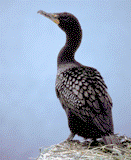United States Department of Agriculture, National Wildlife Research Center: Symposia

Symposium on Double-Crested Cormorants: Population Status and Management Issues in the Midwest
Date of this Version
December 1997
Abstract
We prepared this review of the status and management of double-crested cormorants (Phalacrocorax auritus) in Ontario, with management options, in response to concerns expressed about possible negative impacts of large numbers of the birds on fish stocks, and vulnerable, threatened and endangered species. Double-crested cormorants are native to Ontario and were first recorded breeding on Lake of the Woods in northwestern Ontario in the late 1700’s. The birds spread eastward to colonize all of the Great Lakes by the 1930’s. A decline in cormorant populations on the Great Lakes from the 1950’s to the 1970’s has been attributed mainly to chemical contaminants and resulting lower reproductive success. Populations on the Great Lakes have increased dramatically since the 1970’s in response to reduced contaminant levels and increased abundance of small forage fish. There were an estimated 36,000 breeding pairs on the Canadian Great Lakes in 1997, with increasing numbers found on inland water bodies. Double-crested cormorants are protected in Ontario, and there are no population control programs. With increasing numbers of the birds, population management options were considered, ranging from no controls, to controls in specific local areas, to widespread controls. The latter does not appear to be justified because evidence suggests that cormorants have not had significant effects on sport, commercial or small forage fish on an ecosystem basis. Control measures in specific local areas may be justified for certain management purposes, such as protection of endangered species.

